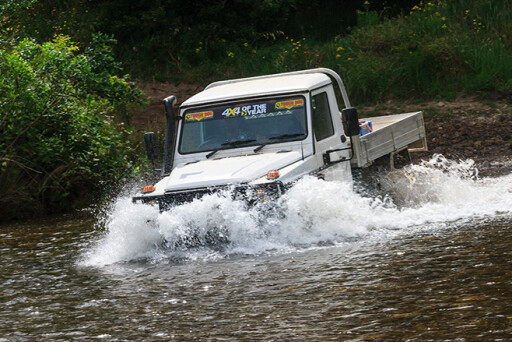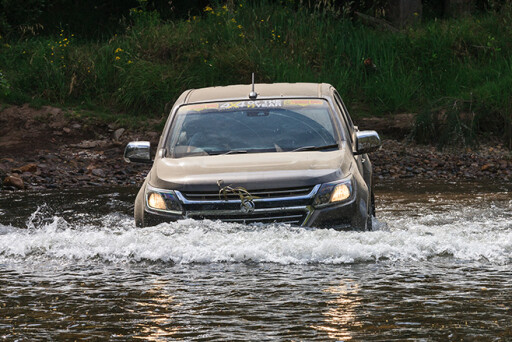
WE were confronted by several water crossings while driving through the Victorian High Country on the recent 4X4 Of The Year test. And, while none of them were particularly deep, we approached them all with a fair degree of trepidation.
Many years ago on a 4X4OTY test I watched in horror as a bow wave went over the bonnet of a Porsche Cayenne Turbo. I remember wondering how much money it would cost to replace the twin-turbo V8 if it copped a gob-full of water… and how I would explain the situation to Porsche’s PR Manager. Luckily the Porsche made it across, but the following SsangYong did not, spluttering to a halt in the middle of the creek and requiring a tow to the other side.
My heart nearly stopped when the bloke behind the wheel then attempted to start the SsangYong’s water-flooded engine. I yelled at him to stop, which he did, and we spent the next 30 minutes pulling the spark plugs, cranking the engine and pumping the water out of it. We then put the plugs back in and crossed our fingers as the ignition key was turned, and the little Korean sparked back to life. Another awkward phone call to a PR Manager had been averted, although later that week I told him what had happened so his mechanics could check out the vehicle when we returned it.
 Fast forward to this year, and of the nine vehicles in our convoy there were four we didn’t have to worry about too much: the GU Patrol tucker truck, the Tough Dog Navara, the Mercedes-Benz G-Professional and the Toyota LandCruiser 79, all of which were fitted with snorkels (in fact, the latter two come standard with snorkels). The other five vehicles (all 4X4OTY contenders) were not snorkel-equipped. They were the Haval H9, Holden Colorado, Holden Trailblazer, Mitsubishi Pajero Sport and Volkswagen Amarok.
Fast forward to this year, and of the nine vehicles in our convoy there were four we didn’t have to worry about too much: the GU Patrol tucker truck, the Tough Dog Navara, the Mercedes-Benz G-Professional and the Toyota LandCruiser 79, all of which were fitted with snorkels (in fact, the latter two come standard with snorkels). The other five vehicles (all 4X4OTY contenders) were not snorkel-equipped. They were the Haval H9, Holden Colorado, Holden Trailblazer, Mitsubishi Pajero Sport and Volkswagen Amarok.
These snorkel-less contenders have claimed maximum wading depths ranging from 700mm down to 500mm, which is only about knee height, so our concern was real.
While the Haval H9 has one of the better claimed maximum wading depths of 700mm, you still have to be very careful crossing any body of water in a petrol-powered 4x4. It only takes a small splash to land in the wrong place under the bonnet to make the fire go out, potentially leaving you stranded up both the literal and proverbial creeks. The Pajero Sport also has a claimed maximum wading depth of 700mm, and with a diesel donk there’s a good chance its engine will keep running with water splashing about under the bonnet.
The worry levels increase slightly when fording a river in either of the Holdens, which both have a quoted maximum wading depth of 600mm. This modest figure is somewhat surprising, as a glance under the bonnet shows the air intakes on both the Colorado and Trailblazer are up quite high through their respective inner guards and that most of the electrical components are situated high in the engine bay.
 Then there’s the Amarok with a claimed wading depth of just 500mm. The engine’s air intake looks vulnerable to water ingress (it’s behind one of the headlights) and the alternator sits quite low in the engine bay. In fact, for a photo shoot at a river crossing, we left the Amarok parked on the bank while the other 4X4OTY contenders crossed back and forth for an all-important splash shot. Nevertheless, driven carefully, the Amarok didn’t have any problems with any of the other water crossings we tackled on the 4X4OTY test and it made it through the week without a problem.
Then there’s the Amarok with a claimed wading depth of just 500mm. The engine’s air intake looks vulnerable to water ingress (it’s behind one of the headlights) and the alternator sits quite low in the engine bay. In fact, for a photo shoot at a river crossing, we left the Amarok parked on the bank while the other 4X4OTY contenders crossed back and forth for an all-important splash shot. Nevertheless, driven carefully, the Amarok didn’t have any problems with any of the other water crossings we tackled on the 4X4OTY test and it made it through the week without a problem.
It’s strange that the Amarok’s wading depth is so limited on what is otherwise a well-engineered vehicle with surprising off-road capability. Of course, the best water-crossing solution for anyone who buys an Amarok, or any other 4x4 for that matter, is to fit a snorkel. Ensure it’s a good quality snorkel that’s been properly installed, as dodgy connections or cracked plastic will let water in. Other mods that will help your vehicle survive deep-water crossings include extensions on breathers for diffs, gearbox and transfer case, but bear in mind that water can still find its way past seals, especially when hot mechanical components are plunged into cold water. After any trip that involves water crossings, you should always check all oil for a milky appearance and replace if necessary.
Finally, good door seals are a great defence against water damage. I lost a camera recently when negotiating a deep-water crossing; it was in a backpack on the floor of ARB’s Off Road Icons Land Rover Defender. I should’ve known better.

COMMENTS